
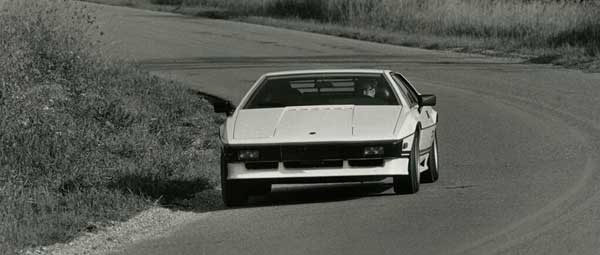
1983 Lotus Esprit Turbo
Rule, Britannia! (All others stand back.)
From the November 1983 Issue of Car and Driver
Colin Chapman is not dead, not really. His spirit is out here still, kicking tail in the furry wallops. The furry wallops are at your disposal on any narrow little back road, particularly in England, when you're in the driver's seat of a Lotus Esprit Turbo. Your primary concern is with the demented single-mindedness of your turbocharger, and your secondary concern is with the remarkable width of your flanks. England's cloistered, raveling lanes, like some of our own country roads, can barely contain the car, and this is where you learn its truths.
Along the edges of the roads is a furry streaking of soft grasses, tussocks puffing their fringes over the pavement, a constant buffer brush that whishes your tires and defines the narrow, pinching edge of challenge. As you dogleg through the grassy fur of the valley at an average approaching 120 mph, the turbo instantly wallops your backside with each cue of the throttle, pow-in-the-back whoop! pow-in-the-back whoop! pow! gearing up, whoosh the furry grass, brake grunt, whoosh, pow! pow! big lateral wallops under blinks of shade at the corners, little wrist-wriggling wallops through the tight steering, and big longitudinal wallops from the engine and the brakes on the sunny straights. You tootle down to idle to thread through villages at breakfast time, and you learn more about the car. Villages are unprepared for the sight of the Giugiaro-designed doorstop so early in the day. Mouths form little "Oh, look!" circles, and boys in kneepants lean out as if magnetized as the Esprit Turbo burbles through the roundabout and rustles out the other side of town past smiling girls in miniskirts, and the walloping begins again.
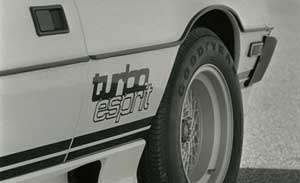
Lotus development engineer Roger Becker says, in essence, that the Esprit Turbo was intended to provide a work-intensive environment for its driver—the sort of experience an aggressive street driver would expect from a race car if he'd never driven one, yet not an experience so intensely racy as to scare him off.
Well done, Mr. Becker. The Esprit Turbo is a slam-home wedge to be driven into a perceived gap in the marketplace with all the considerable forcefulness it can muster, and this gap among supercars is perfectly suited to a rakishly bodied, mid-engined, turbo-monstered rocketry exercise that's delivered from the United Kingdom with enough performance in all categories to send dilettantes screaming for cover.
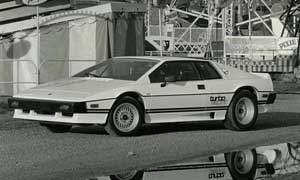
Oh, they'll love the body, no problem there. It's a two-piece clamshell design, upper and lower halves of fiberglass-reinforced plastic that join at the rub strip, and it looks wonderful. It is, after all, the work of Italian master designer Giorgetto Giugiaro, creator of such mid-engined masterpieces as the striking De Tomaso Mangusta and the functional BMW M1 among others. The M1, in fact, is widely regarded as the all-time packaging, quality civility, and performance king among mid-engined cars; but it is now out of production, and only a few specially certified cars ever made it into the United States anyway. Yet even in its role of virtual nonexistence in this country, the M1 made hard-core car guys aware of a gap among exotics. Factory-legal exotics were great to look at one reasonably exciting to drive, but they just didn't take your breath away.
Colin Chapman was just the man to put an end to that sorry state of affairs. The original Esprit appeared in 1975, and people said: Right, lovely to look at, nice to drive, modestly quick, a few problems here and there. Chapman, just as he had with all of Lotus's previous cars, began beavering away at the Esprit to make it better, faster, more complete. "Faster" was italicized in his brain. The car, in fact, had room allotted in its engine bay for a V-8, Chapman fantasizing among Lotus's Formula 1 trophies and World Championships that grafting two of his fine four-cylinders together would be a dandy thing to do. But eventually turbocharging got the nod, and with it came major changes to the Esprit to strengthen it, to make it more livable, and to turn it into a more practical car.
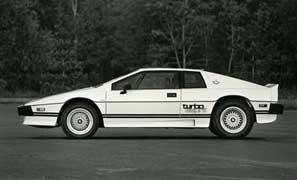
The Esprit Turbo was quickly acknowledged as one of the fastest cars in the world, the flag-waving British press in particular ballyhooing Chapman's latest work as if they'd been at God's elbow for the Second Coming. Unfortunately, when Chapman died shortly before Christmas last year, Lotus was in shaky financial health, the ink was barely dry on its American marketing plan, and the Esprit Turbo was only halfway through the federalization process.
Now, nearly a year later, that's all changed. Chapman's right-hand men banded together, borrowed financial support from American Express, which should soon be paid off, sold sixteen percent of the company to Toyota, for whom considerable development work has already been done, and signed a new and more clearly conceived marketing plan for the United States. And they are already delivering fully federalized cars.
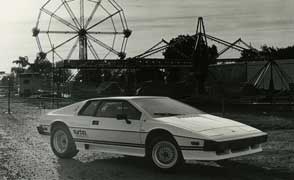
Despite their federalization, these Turbo Esprits show no sign of the sort of feebleness that sometimes comes with U.S. adaptations. They remain such strong performers that few of the aforementioned dilettantes are likely to get in line, and it's a lead-pipe cinch that none of those who do queue up will be hurting in the bank account. The first full-page newspaper ad from Lotus Performance Cars, L.P., the American importing company (530 Walnut Street, Norwood, New Jersey 07648; 201-784-0726), warns Turbo buyers not to expect much change from a $50,000 bill. Eventually there should be about 40 dealers snapping up $50,000 bills for a total of no fewer than 350 cars this first year, perhaps as many as 600.
No kit car, this Lotus. When you look underneath, there are no more signs of the atomic Erector sets that used to make up Chapman's cars. Esprit Turbos are full of modern construction techniques and professionally thought-out solutions, and so it is that they must be considered in light of the marketplace. The Ferrari 308 is the most direct competitor, but it isn't as quick. The Maserati Merak and the Lamborghini Jalpa, almost invisible over here, haven't nearly enough heft in their knickers to face off against the Turbo Esprit. The Chevrolet Corvette isn't yet good enough to qualify. The Porsche 928S is a great car and wicked in appearance, yet it lacks the outright flash of its mid-engined competitors. Does this mean that the Turbo Esprit, the only Lotus model scheduled to be imported here for some time to come, has leapt in a single bound right to the top of the most exclusive heap of all?
What a package it is! The turbo engine is all slam, bam, thank you, ma'am! It gives a whole new meaning to the term "small block." Its aluminum block and head contain only four cylinders and 2.2 liters of displacement, but from this hand-assembled 133 cubic inches, its sixteen valves, and its Garrett AiResearch TCO3 turbocharger with its 8.0 pounds of boost comes a smooth and astounding 205 bhp at 6000 to 6500 rpm. This is only 5 bhp less than Turbos sold in England and Europe. The small loss is due primarily to increased barrel sizes in the dual-throat Dellorto carburetors (up from 40 to 45mm) and to extra full-power enrichment jets.
Fuel injection may arrive for this engine at some point, and this could help its mediocre 14-mpg EPA city fuel-economy rating, but otherwise, who cares? You've already got dynamite under your foot, enough to propel you to 60 mph in 6.4 seconds, through the quarter-mile in 14.6 seconds at 95 mph, and to a top speed of 141 mph.
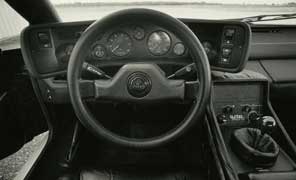
Moreover, the 2.2-liter's drivability is excellent, offering nothing less than the throttle response of a much larger normally aspirated engine, so you never wind up having to gauge a lag factor into the Esprit's line out of a corner. It's a natural, a point-and-boot artist at your disposal. The four-wheel discs slow the car effectively, though a full stop from 70 mph requires 218 feet; stopping distances would be shorter if the front-rear braking balance were better. Surprisingly, the Goodyear NCTs and the all-independent suspension provide only 0.78 g of cornering force; they do, however, provide an excellent ride and comfortable over-the-road behavior. (It should be noted that the limit adhesion we measured is a country mile from Lotus's 1.05-g advertising claim.) The BBS wheels are 7.0 by 15 inches in front, 8.0 by 15 in the rear, and the NCTs are VR-rated 195/60s front and 235/60s rear.
Only two drawbacks in chassis tuning have made themselves known so far. The front tires, which carry only 21 psi cold, howl like the very devil when cornering even moderately hard (cop alert!), though Roger Becker says this is due also to the carefully compromised construction and compound of the tires, perhaps explaining the "firm but supple" (famous, that one) ride. The second problem is that the nose of the car has unfortunately been boosted to meet U.S. bumper-height requirements, which not only does away with some of the aggressive wedge-down appearance but also induces a slight sniffiness of nose-float at very high speeds, intruding just a hint of extra play into the otherwise very snug steering.
Generally, however, most of the U.S.-inspired changes have been good for the Esprit Turbo, from enlarged cockpit and luggage space to engine-cooling and ventilation improvements and mandatory air conditioning. The finish of the paint and trim is excellent, loose ends almost nonexistent. The interior is Connolly-leathered, beautifully instrumented, and for the most part well designed, but slim drivers of average height or less will be put off by the one-piece bucket seats, which have been widened and lowered in honor of big American drivers, leaving those not suited to the National Football League at an almost total loss for cornering support. Fully adjustable seats should be available in any car as expensive as the Esprit Turbo. Lotus will provide its snugger European seats to those who care enough to demand them, but until then, the skinny rich among us will be struggling for stability at all the wrong times, muttering about the already high placement of the wheel, the poor heel-and-toe spacing of the pedals, and the excess padding atop the console (née backbone chassis), which thwarts gear-changing for those short of arm. Still, fixes are comparatively easy and well worth the time, considering the rewards at hand.
The Lotus Esprit Turbo is a real car, not a half-finished imitation. It is full of dash and thrills and heart, and we hope Chapman's quiet death came with a smile on his lips. He deserved at least that.
Technical Highlights – Don Sherman
Lotus, always iconoclastic, once again flies in the face of convention by using carburetion instead of fuel injection for the Turbo Esprit. The factory cites cost concerns and excessive development time as the reasons for avoiding injection in this case. Two Dellorto DHLA 45mm two-barrel side-draft carburetors feed the sixteen-valve cylinder head in a blow-through arrangement. Boost is supplied by the ever popular AiRe-search TC.03 turbocharger, with the waste gate (made in Australia by Normalair Garrett, an AiResearch subsidiary) set at 8.0 psi.
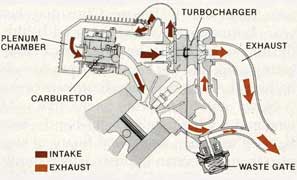
Lotus takes great pride in the fact that. the throttle-plate-to-intake-valve passages are actually shorter than those in the normally aspirated version of this engine. (Lotus engineers claim this is an aid to fast boost and throttle response, which the Esprit does have. Nevertheless, we've seen excellent results in several turbo installations that have lengthy intake passages.) Other special features include dual tracts to the turbine inlet, a carefully structured passage between the turbo's compressor and the plenum chamber, and a waste-gate flow that meets the main exhaust stream at the catalytic converter.
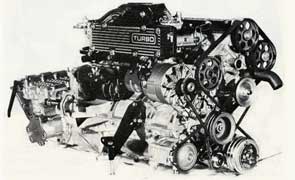
Inside the Lotus type-910 four-cylinder, the compression ratio has been lowered from 9.5:1 to 7.5:1 to avoid detonation (no knock sensor is used). The intake- and exhaust-valve timing has not been altered from the specifications of the normally aspirated engine, but valve lift is significantly higher. In U.S. trim, the Lotus factory rates this package at 205 net horsepower from 6000 to 6500 rpm, down only five horsepower from the European output.
As the saying goes, it's not the cat, but how you skin it.
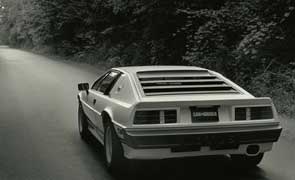
Counterpoint– Jean Lindamood
It's wonderful to drive an English exoticar again. The Germans give us power and rock-hard solidity. The Italians offer voluptuous shapes that feed our aesthetic dreams, and machinery that is the substance of our hardware fantasies. But only the British can provide the elusive blend of supple ride and precise handling that is the envy of all carmakers.Instead of trying to hammer road imperfections flat, as a German exotic would, the Esprit moves with them, absorbing the rough stuff while maintaining full grip. This more subtle approach extends to the Lotus's powerplant. Whereas the German car depends on displacement, technology, and relentless development, and the Italian car on a multiplicity of cylinders, camshafts, and carburetors, the Esprit relies on a small, highly refined, totally modern turbo four.
These differences may not make the Esprit the best of the exoticars, but they make it a unique candidate for satisfying one's automotive whims—which is exactly how I define the word "exoticar." —Csaba Csere
I have driven Double-Oh-Seven's latest signature-model Lotus, and I'm prepared to pronounce it fit for a star of Bondian dimensions. Just don't mistake it for a real car. As with most exotics, the Esprit Turbo's highs are higher, but its lows are lower.
The scrunched-up driving position, for instance, would get laughed out of a GM design studio. Your average Supra's interior has the Lotus's cabin covered. In fit and finish, creature comforts, seat technology, quietness, air-conditioner performance—you name it—the Toyota is a much more sophisticated and livable automobile.
Ah, but few other cars will make your blood rush like an Esprit Turbo. It looks like a star. The shriek of the turbo at full suck is pure Formula I . The handling has a fine edge to it that few of the world's cars can match. No one, with the exception of maybe Ralph Nader, could remain immune to this car after a turn behind the wheel. And that, ultimately, is what exotics are all about: intensity in the way they look and in the way they drive. On that score, I'd rate the newest Lotus a perfect ten. —Rich Ceppos
I have three things on my mind when I slide down into a Turbo Esprit. Above all, I want to head straight for the freeway so I can go fast and hear that engine wind out. What a noise! It's a raspy, gnarling Goliath roar that will make your short hairs stand on end. It might be even more unnerving than the Countach's wail. If it weren't for the Esprit's crummy shift linkage, I'd be jumping off and on the freeway at every other exit just to hear that noise again and again.
When that wears thin (sure), I head toward the U of M student ghetto in Ann Arbor to watch the quaddies fall off of curbs as we slip on down the road. Giugiaro is the undisputed styling king of the lean, mean, funky theme. Think of it: the Esprit design is almost twelve years old, and it still knocks the socks off the student crop.
Now this is perhaps a bit forward of me, but the third thing I think about when I drive the Esprit is sex.
|
|